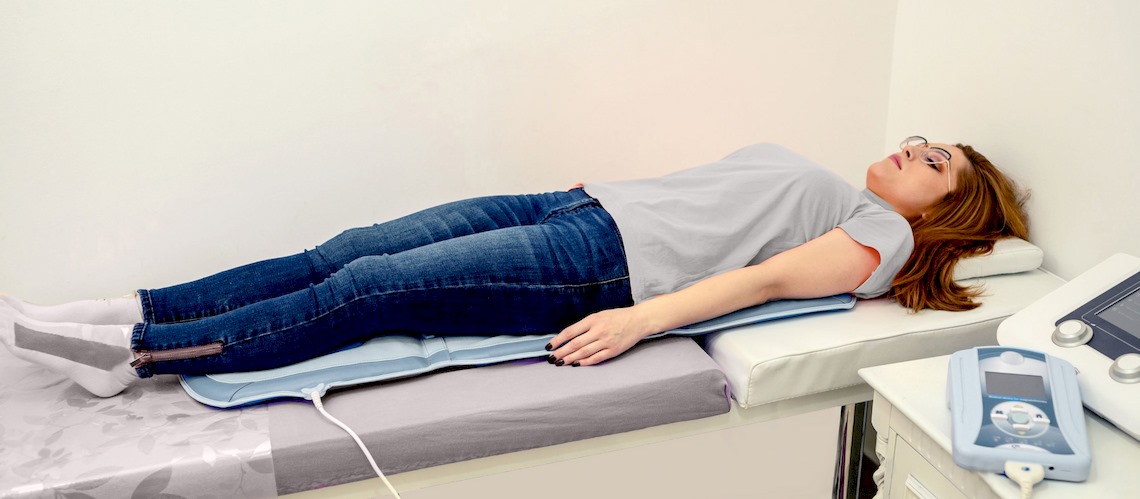The Excellence Nexus framework focuses on achieving peak performance across six key domains: Physical, Mental, Emotional, Spiritual, Prosperity, and Impact. Pulsed Electromagnetic Field (PEMF) therapy, a non-invasive modality that stimulates the body’s natural healing processes, serves as a powerful tool to optimize health and well-being in these areas. By reducing pain, enhancing mental clarity, stabilizing emotions, and promoting overall vitality, PEMF therapy empowers individuals to excel in all aspects of life.
Applications of PEMF Therapy in the Excellence Nexus Framework
1. Physical Peak
Achieving peak physical performance demands optimal health, rapid recovery, and sustained energy. PEMF therapy directly supports these goals by:
- Reducing inflammation and pain, essential for injury recovery (Bagnato et al., 2016; Foley-Nolan et al., 1990).
- Enhancing microcirculation, improving oxygen and nutrient delivery to tissues (Strauch et al., 2009).
- Boosting physical energy levels and reducing fatigue, helping individuals sustain high physical output (Ghanbari Ghoshchi et al., 2024).
Athletes and high performers benefit significantly from PEMF therapy, which has been shown to reduce muscle soreness, accelerate recovery times, and improve musculoskeletal function (Tong et al., 2022).
2. Mental Peak
Mental clarity, sharpness, and creativity are fundamental to peak performance in cognitive tasks. PEMF therapy promotes mental acuity by:
- Improving cerebral blood flow and oxygenation, critical for brain health (Rosch & Markov, 2004).
- Modulating cellular energy production, which enhances focus and cognitive endurance (Chang et al., 2003).
- Supporting neurological function, including memory and problem-solving abilities, as observed in studies on motor and cognitive improvements in neurological conditions (Sandyk, 1995).
This combination of physical and neurological benefits positions PEMF therapy as an effective tool for maintaining and enhancing mental performance in demanding environments.
3. Emotional Peak
Sustaining peak emotional performance requires resilience, stress management, and mood stability. PEMF therapy contributes to emotional well-being by:
- Reducing stress and anxiety, as demonstrated by (Rosch & Markov, 2004, Chapter 44).
- Modulating inflammatory responses, which are linked to emotional dysregulation (Ganesan et al., 2009).
- Promoting relaxation and a sense of calm, making it easier to navigate high-pressure situations (Foley-Nolan et al., 1990).
Emotional stability fosters better decision-making, interpersonal interactions, and the ability to handle personal and professional challenges with poise.
4. Spiritual Peak
Achieving spiritual excellence involves aligning the body, mind, and spirit in harmony. PEMF therapy supports this alignment by:
- Reducing physical discomfort and emotional strain, which can hinder spiritual connection (Markov, 2007).
- Creating conditions for introspection and mindfulness through improved relaxation and balance (Rosch & Markov, 2004).
For example, a professional under high stress who incorporates PEMF therapy alongside meditation may experience reduced physical tension, enabling a more profound sense of clarity and alignment. This foundation of well-being supports spiritual growth and excellence.
5. Prosperity Peak
Prosperity peak is about achieving sustained success and abundance, which relies on physical health, mental clarity, and emotional stability. PEMF therapy indirectly supports prosperity by:
- Enhancing productivity and focus, allowing individuals to approach challenges with greater creativity and efficiency (Chang et al., 2003).
- Boosting physical energy and resilience, critical for maintaining long-term success (Ghanbari Ghoshchi et al., 2024).
- Supporting emotional balance, enabling better interpersonal relationships and strategic decision-making (Rosch & Markov, 2004, Chapter 44).
The cumulative benefits of PEMF therapy create the conditions necessary for sustained achievement and personal growth.
6. Impact Peak
The ability to make a meaningful difference in the world requires optimal physical, mental, and emotional health. PEMF therapy supports impactful living by:
- Providing the energy and resilience needed to pursue challenging goals (Bagnato et al., 2016).
- Enhancing cognitive and emotional stability (Sandyk, 1995; Rosch & Markov, 2004), which are essential for leadership and innovation.
By optimizing performance across all domains, PEMF therapy empowers individuals to maximize their contributions to society and leave a lasting legacy.
Benefits of PEMF Therapy in the Excellence Nexus
This section summarizes the key benefits of PEMF therapy across the six domains, consolidating its role in achieving excellence.
1. Enhanced Recovery and Performance
- Accelerates recovery from injuries and physical exertion (Henry et al., 2008).
- Reduces inflammation and pain, enabling consistent physical excellence (Ganesan et al., 2009).
2. Cognitive Enhancement
- Improves focus, memory, and problem-solving abilities (Sandyk, 1995).
- Enhances decision-making and creativity, critical for sustained mental performance (Pilla, 2013).
3. Emotional Stability
- Promotes resilience and mood stability (Rosch & Markov, 2004).
- Reduces stress and enhances relaxation, helping individuals thrive under pressure (Foley-Nolan et al., 1990).
4. Holistic Well-being
- Integrates physical, mental, and emotional health, aligning with the Excellence Nexus framework (Markov, 2007).
- Creates a balanced foundation for achieving excellence in all life domains (Rosch & Markov, 2004).
How to Integrate PEMF Therapy in the Excellence Nexus Framework
- Incorporate Scheduled Sessions
Regular use of PEMF therapy ensures consistent benefits:- Athletes can use it post-workout for recovery (Ghanbari Ghoshchi et al., 2024).
- High performers can integrate sessions during downtime to recharge mentally and emotionally.
- Tailor Therapy to Goals
Adjust intensity and frequency to align with specific needs:- Use higher intensity for injury recovery (Bagnato et al., 2016).
- Opt for low-intensity sessions for relaxation and cognitive focus (Chang et al., 2003).
- Monitor and Optimize
Track improvements across the six domains of the Excellence Nexus and refine your PEMF therapy regimen to maximize results. - Combine with Complementary Practices
PEMF therapy works synergistically with:- Exercise for enhanced physical performance.
- Meditation for emotional and spiritual alignment.
- Balanced nutrition to support cellular repair and vitality (Mansourian & Shanei, 2021).
Conclusion
PEMF therapy is a scientifically validated, versatile tool for achieving peak performance within the Excellence Nexus framework. By enhancing physical vitality, mental clarity, emotional stability, and overall well-being, PEMF therapy enables individuals to thrive in all life domains. Integrating PEMF therapy into your routine can help you sustain peak performance, make a lasting impact, and achieve excellence in personal and professional life.
Take the next step by consulting a healthcare professional or exploring PEMF devices to integrate this powerful therapy into your life and unlock your full potential.
References:
Bagnato, G.L. et al. (2016) ‘Pulsed electromagnetic fields in knee osteoarthritis: a double-blind, placebo-controlled, randomized clinical trial’, Rheumatology (Oxford, England), 55(4), pp. 755–762.
Chang, W.H. et al. (2003) ‘Therapeutic Effects of Electromagnetic Fields’, in P. Stavroulakis (ed.) Biological Effects of Electromagnetic Fields: Mechanisms, Modeling, Biological Effects, Therapeutic Effects, International Standards, Exposure Criteria. Berlin, Heidelberg: Springer, pp. 624–732.
Foley-Nolan, D. et al. (1990) ‘Pulsed high frequency (27 MHz) electromagnetic therapy for persistent neck pain: A double-blind, placebo-controlled study of 20 patients’, Orthopedics, 13(4), pp. 445–451.
Ganesan, K. et al. (2009) ‘Low-frequency pulsed electromagnetic field: A viable alternative therapy for arthritis’, Indian Journal of Experimental Biology, 47(12), pp. 939–948.
Ghanbari Ghoshchi, S. et al. (2024) ‘Pulsed Electromagnetic Field (PEMF) stimulation as an adjunct to exercise: A brief review’, Frontiers in Sports and Active Living, 6.
Henry, S.L. et al. (2008) ‘The Effect of Magnetic Fields on Wound Healing’, Eplasty, 8, e40.
Mansourian, M. and Shanei, A. (2021) ‘Evaluation of Pulsed Electromagnetic Field Effects: A Systematic Review and Meta-Analysis on Highlights of Two Decades of Research’, BioMed Research International, 2021, pp. 1–22.
Markov, M.S. (2007) ‘Expanding use of pulsed electromagnetic field therapies’, Electromagnetic Biology and Medicine, 26(3), pp. 257–274.
Rosch, P.J. and Markov, M.S. (eds.) (2004) Bioelectromagnetic Medicine. Boca Raton: CRC Press.
Sandyk, R. (1995) ‘Parkinsonian micrographia reversed by treatment with weak electromagnetic fields’, International Journal of Neuroscience, 81(3–4), pp. 83–93.
Strauch, B. et al. (2009) ‘Evidence-based use of pulsed electromagnetic field therapy in clinical plastic surgery’, Aesthetic Surgery Journal, 29(2), pp. 135–143.
Tong, J. et al. (2022) ‘The Efficacy of Pulsed Electromagnetic Fields on Pain, Stiffness, and Physical Function in Osteoarthritis: A Systematic Review and Meta-Analysis’, Pain Research & Management, 2022, Article ID 9939891.




